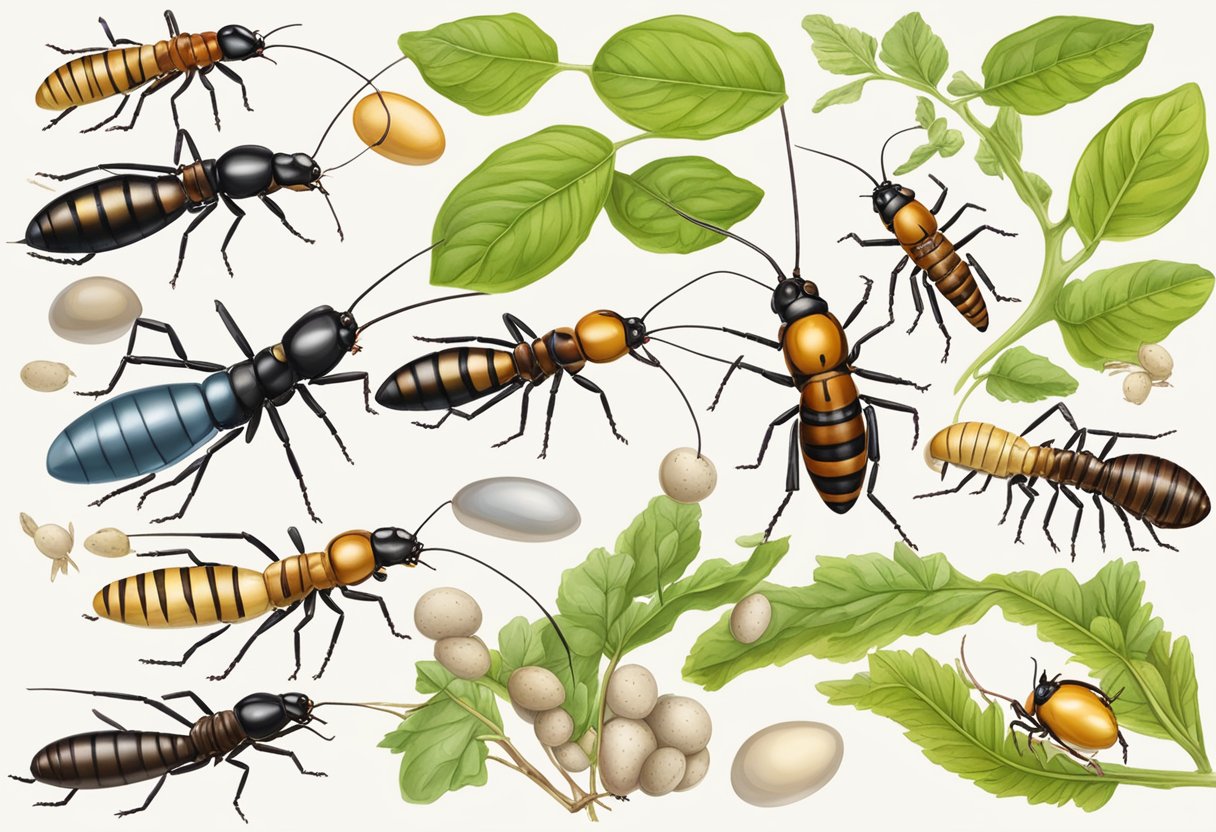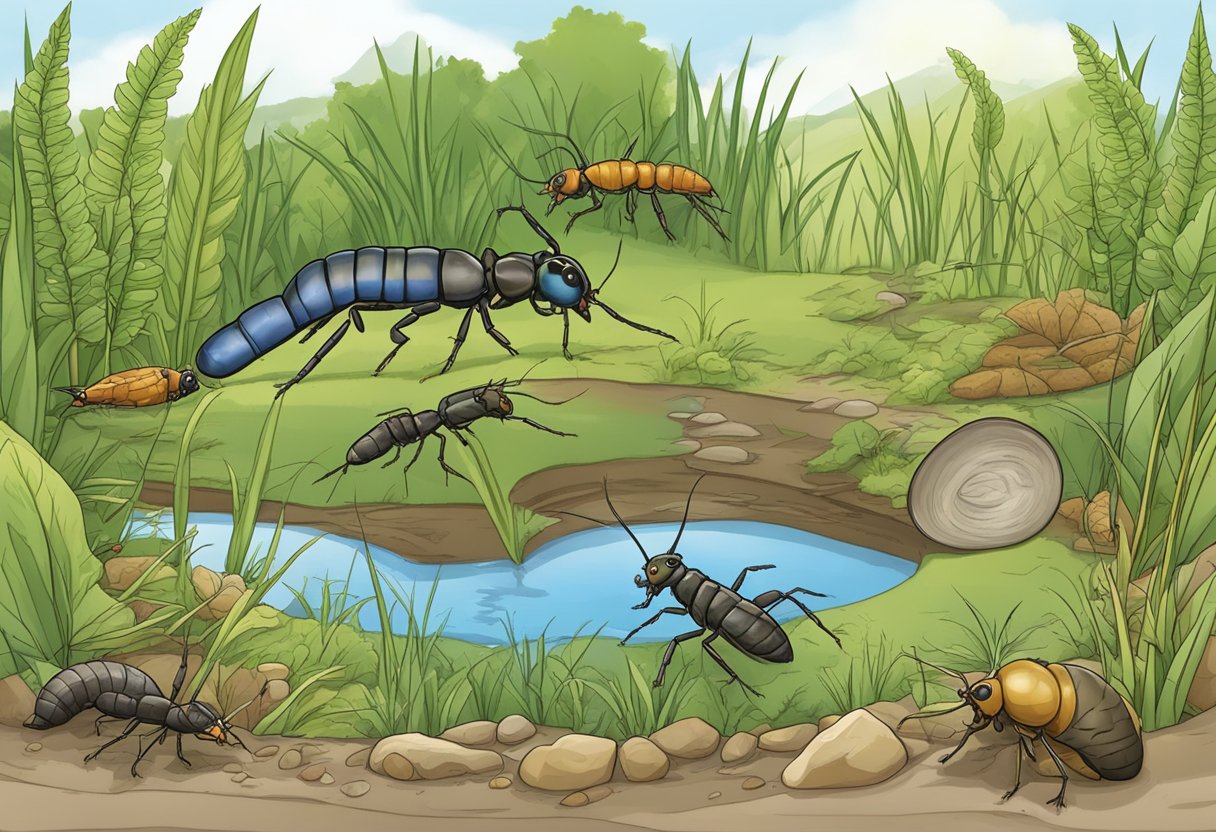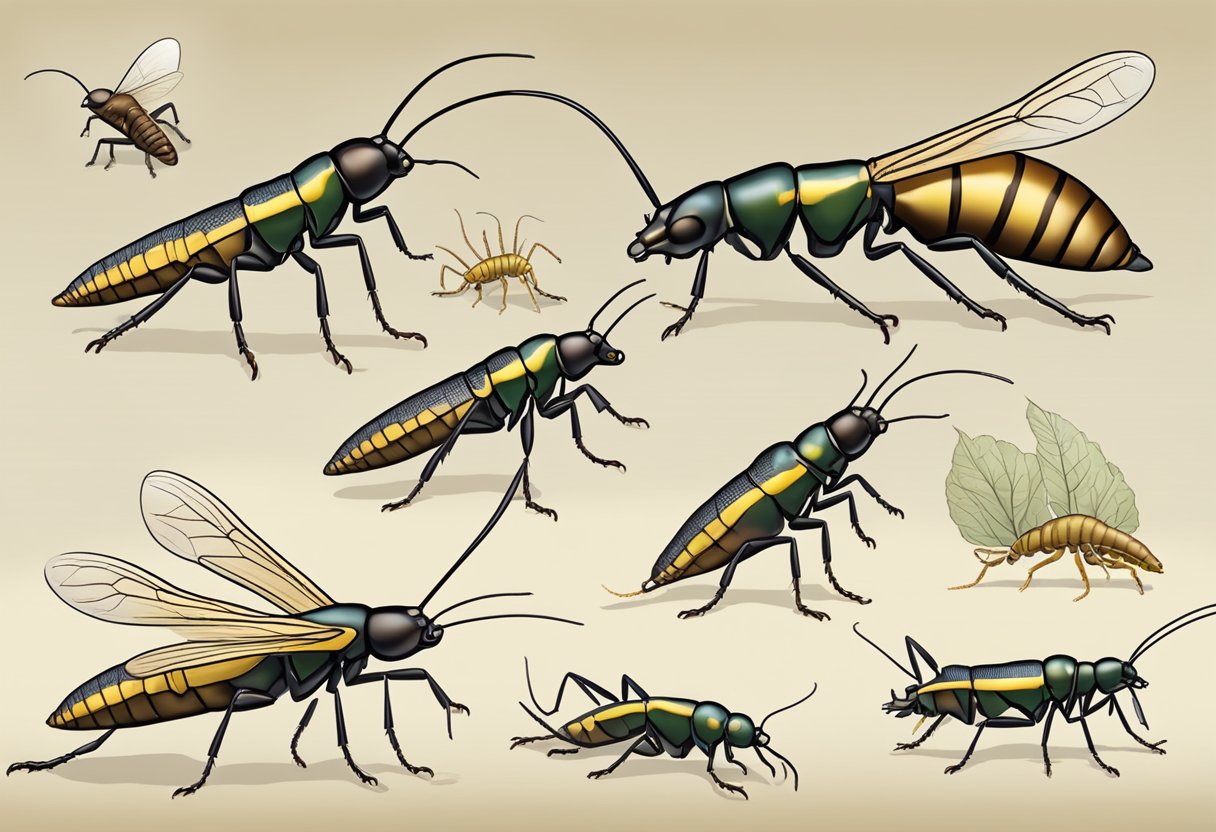Earwigs, also known as Dermaptera, are insects that are commonly found throughout the Americas and Eurasia. They are known for their distinctive pincers located at the end of their abdomens, which they use for defense and to capture prey. Earwigs have a unique life cycle that consists of three stages: egg, nymph, and adult.

The earwig life cycle begins with the female laying eggs in soil or other organic matter. Once the eggs hatch, the nymphs emerge and begin to feed on small insects and vegetation. As they grow, they molt several times before reaching adulthood. Adult earwigs can live up to one year and continue to feed on small insects and vegetation.
There are several species of earwigs, each with their own physical features and habits. Some species are known for their ability to fly, while others are ground dwellers. While earwigs are generally considered a nuisance pest, they can cause damage to plants and gardens if left unchecked. Understanding the earwig life cycle and habits can help homeowners and gardeners prevent infestations and protect their plants.
Related Posts:
Earwig Origin and Habitat

Earwigs are insects that belong to the order Dermaptera. The scientific name for the order, “Dermaptera”, is Greek in origin, stemming from the words derma, meaning skin, and pteron (plural ptera), wing. It was coined by Charles De Geer in 1773 [1].
Earwigs are found all over the world, with over 2,000 species known to exist. The European earwig, also known as the common earwig, is one of the most common species in the world. It is native to Europe and has since been introduced to other parts of the world, including North America [2].
Earwigs prefer to live in dark, moist environments, such as under rocks, in soil, and under leaf litter. They are also commonly found in gardens, where they feed on plants and other insects. The ringlegged earwig, for example, is commonly found in gardens and fields in North America. They are known to feed on aphids, mites, and other small insects [3].
Earwigs are adaptable to different climates, but they generally prefer warm and humid environments. They are more active at night and are attracted to light sources, which is why they are commonly found near porch lights and streetlights. In colder environments, earwigs may seek shelter indoors, which can lead to infestations in homes [1].
In summary, earwigs are found all over the world, with the European earwig being one of the most common species. They prefer to live in dark, moist environments, such as under rocks and in soil, and are adaptable to different climates, but generally prefer warm and humid environments.
Physical Characteristics of Earwigs

As insects, earwigs have three main body parts: the head, thorax, and abdomen. Their bodies are typically brown or black in color and range in size from 5 to 25 mm. They have flattened bodies and long antennae that are used for sensing their environment.
Earwigs are known for their forceps, which are two curved appendages at the end of their abdomen. These forceps are used for a variety of purposes, including defense, mating, and capturing prey. Despite their intimidating appearance, earwigs are not harmful to humans and do not bite.
In addition to their forceps, earwigs also have wings. However, not all earwigs can fly, and those that can typically only fly short distances. Their forewings are hardened and serve as protection for their membranous hindwings.
Earwigs are also characterized by their flattened bodies and long legs. They have six legs in total, with the front pair being the shortest. Earwigs are also known for their cerci, which are two small appendages at the end of their abdomen.
Overall, earwigs have a distinct appearance and are easily recognizable by their forceps and flattened bodies.
Related Posts:
Life Cycle of an Earwig
As we all know, earwigs are insects that belong to the order Dermaptera. Earwigs have a fascinating life cycle that consists of several stages. In this section, we will discuss the life cycle of an earwig in detail.
The life cycle of an earwig begins with an egg. Female earwigs lay their eggs in the soil, usually in the fall. The eggs hatch in the spring, and the young earwigs emerge from the soil. These young earwigs are called nymphs and look similar to adult earwigs, but they are smaller and do not have fully developed wings.
Earwigs undergo incomplete metamorphosis, which means that the nymphs resemble the adults but are smaller and lack wings. As the nymphs grow, they molt several times, shedding their exoskeletons and growing new ones. With each molt, the nymphs become larger and more closely resemble adult earwigs.
After several molts, the nymphs reach adulthood. Adult earwigs have fully developed wings and are capable of flight, although they do not fly very often. Adult earwigs mate and reproduce, starting the cycle all over again.
Earwigs overwinter as adults, hiding in cracks and crevices to avoid the cold. In the spring, the females lay their eggs, and the cycle begins anew.
In summary, the life cycle of an earwig consists of several stages, including eggs, nymphs, and adults. Earwigs undergo incomplete metamorphosis, molting several times before reaching adulthood. Adult earwigs mate and reproduce, starting the cycle all over again. Earwigs overwinter as adults and emerge in the spring to lay their eggs.
Feeding Habits and Prey
As we previously mentioned, earwigs are omnivorous insects. They feed on a wide range of food sources, including plants, fungi, and dead insects. They are mostly active during the night and prefer moist environments.
Earwigs are known to feed on a variety of produce, including leaves and fruit. They have also been observed feeding on aphids and mites, which are common garden pests. Earwigs have been known to feed on dead insects as well, which can be beneficial in reducing the population of other pests.
While earwigs are not considered a major pest, they can cause damage to plants if their populations become too high. They have been known to feed on the leaves of plants, leaving behind small holes. However, it is important to note that earwigs are not the only insects that can cause this type of damage.
In conclusion, earwigs have a varied diet and can feed on a wide range of food sources. While they may cause damage to plants if their populations become too high, they can also be beneficial in reducing the population of other pests.
Earwigs and Human Interaction
As nocturnal insects, earwigs are often found in dark, damp spaces such as under rocks, in crack and crevices, and in gardens. While they are generally harmless to humans, earwigs can become a nuisance when they invade homes through doors and windows in search of food and shelter.
In agriculture, earwigs can be both beneficial and harmful. They are known to feed on other pests such as aphids and mites, but they can also damage crops by feeding on seedlings and fruit. Therefore, proper management and control of earwigs are necessary to prevent crop damage.
Contrary to popular superstition, earwigs do not crawl into human ears and lay eggs. This myth is entirely unfounded and false. Earwigs are wingless insects that cannot fly, and they do not have any interest in human ears.
If earwigs become a problem, there are several ways to control and manage them. Using insecticides and baits can be effective, but it is essential to follow the instructions carefully to avoid harm to humans, pets, and other beneficial insects. An entomologist or pest control professional can provide guidance on the most effective methods of control.
Overall, earwigs are fascinating insects with a unique life cycle and body structure. While they can become a nuisance when they invade homes and gardens, they are mostly harmless and can even be beneficial in some cases.
Related Posts:
Earwig Species and Variations
We have already discussed the general life cycle of earwigs, but it is important to note that there are over 20 species of earwigs in North America alone, and each species has its own unique characteristics.
One example is the ring-legged earwig, which is common in the southern states of America. Unlike the European earwig, the ring-legged earwig does not have wings. They get their name from the dark circles that surround the yellowish coloration of their legs. This earwig is slightly darker than the common earwig and can be found most frequently in the southeastern United States.
Another example is the Labiduridae family of earwigs, which are commonly known as the “striped earwig.” These earwigs have a distinctive shell that is striped in appearance, which sets them apart from other earwig species.
In addition to variations in appearance, earwigs also undergo different instars during their life cycle. For example, some earwig species go through four instars, while others go through five. During these instars, the earwig molts its exoskeleton and grows larger.
It is also worth noting that the shell of the earwig is not as rigid as that of other insects. Instead, it is flexible, allowing the earwig to move and contort its body in ways that other insects cannot.
Overall, the variations in earwig species and instars add to the complexity of their life cycle and make them an interesting and unique insect to study.
Earwigs in the Ecosystem
Earwigs are small insects that play a vital role in the ecosystem. They can be found in various environments, from gardens to forests, and are known for their distinctive pincers at the end of their abdomen. While they are often seen as pests, they also have beneficial effects on the environment.
Earwigs can cause damage to plants by feeding on leaves and flowers. They are particularly attracted to mulch, which provides a suitable environment for them to thrive. However, they also help to control other pests, such as aphids and mites. They are natural predators and can help to keep the population of harmful insects under control.
Earwigs can be found in various locations, such as cracks in walls, under boards, and around the foundation of buildings. They are attracted to moist environments and can often be found under stones or in other damp areas. While they can be a nuisance, they do not pose a significant threat to humans or property.
Overall, earwigs are an essential part of the ecosystem. They may cause damage to plants, but they also have a beneficial effect by controlling other pests. If you are experiencing an infestation of earwigs, it is best to contact a professional to remove them safely and effectively.
